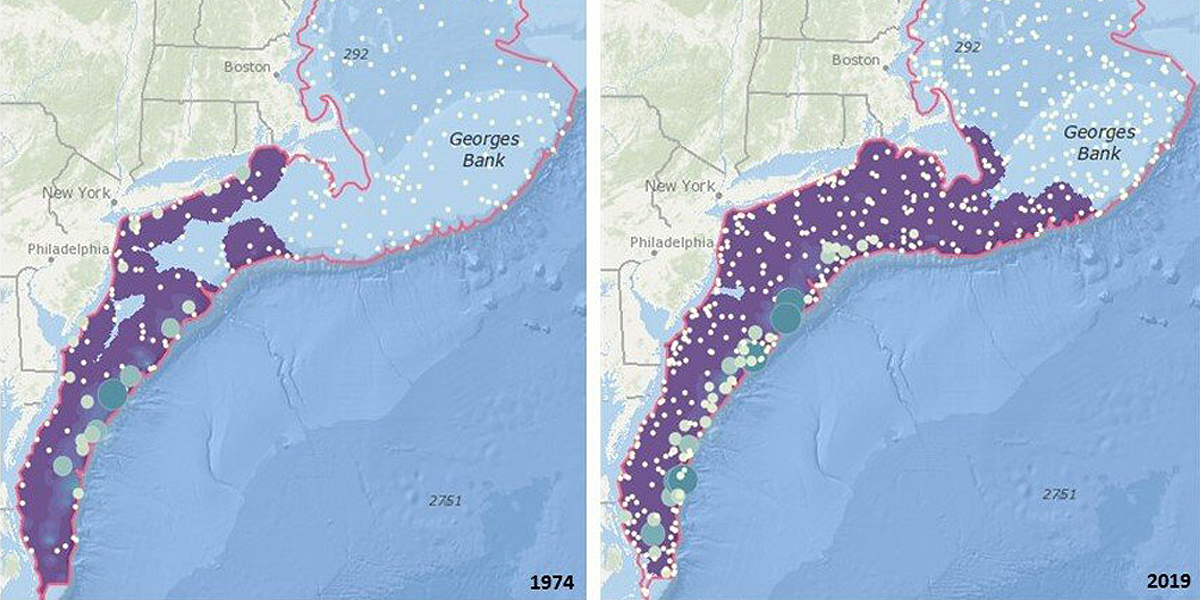NOAA Fisheries launches new tool to better track the location and movement of marine fish in U.S. waters.

The new Distribution Mapping and Analysis Portal (DisMAP) from the U.S. National Oceanic and Atmospheric Administration (NOAA) reveals that the ranges of many marine species are shifting, expanding and contracting in response to changing ocean conditions. The interactive website will improve data sharing and collaboration, facilitate decision-making about fishery management and science and increase overall knowledge of species distribution for stock assessments.
The DisMAP portal displays data from NOAA Fisheries bottom trawl surveys for five regions (Northeast, Southeast, Gulf of Mexico, West Coast and Alaska) and includes a map viewer and graphing capabilities for over 800 marine fish and invertebrate species caught during the surveys. Understanding how species are distributed in space and time, and the factors that drive patterns, are central questions in ecology and important for species conservation and management.

This map shows the portal interface and, here, the module for exploring the range and distribution over time of a single species – in this case Alaskan Plaice in the Gulf of Alaska
"Our climate and oceans are changing, and these changes are affecting the distribution and abundance of living marine resources in our waters," said Rick Spinrad, Ph.D., NOAA administrator. "Changes in fish stocks can have significant economic and cultural impacts for communities and businesses across the U.S. The visualization capabilities of this new tool boost our ability to turn the data NOAA collects into robust decision-making resources for the entire fishery management community, helping build a Climate-Ready Nation."
The portal allows users to select a species of interest and visually examine changes in the distribution over time by looking at both location maps as well as graphs of key indicators of a species distribution (such as change in latitude, depth and range limits). The user can also choose to view changes in distributions at the regional level as an indicator of broader community level changes.

These maps from the portal show changes in black sea bass distribution from 1974 to 2019. Black sea bass expanded approximately 140 miles north over this period of time. Image: NOAA
The changing climate and ocean impact every aspect of NOAA Fisheries' mission—from managing fisheries and aquaculture, to conserving protected resources and vital habitats. "This is one of the most important actions NOAA Fisheries has taken to date to move toward climate-ready fisheries management," said Janet Coit, assistant administrator for NOAA Fisheries, and acting assistant secretary of commerce for oceans and atmosphere and deputy NOAA administrator. "Changes in species distributions are already having significant impacts on key management decisions such as allocations and spatial closures. These impacts are expected to increase with continued changes in the planet's climate and ocean systems."
This new tool was developed in collaboration with the Global Change Ecology and Evolution Lab at Rutgers University to enhance the ability of NOAA Fisheries and its management partners to identify, plan for and respond to climate-driven changes now and in the future. Additionally, increased access to species distribution information and model results from across the nation will help foster a "community of practice" among scientists which can help advance the field, and also provide a useful tool for outreach and education regarding changing fish and invertebrate distributions.
Lead image: Scientists conduct a trawl survey off the coast of New England. Photo: NOAA
Story Source: NOAA Headquarters
Subscribe to our newsletter
Stay updated on the latest technology, innovation product arrivals and exciting offers to your inbox.
Newsletter

